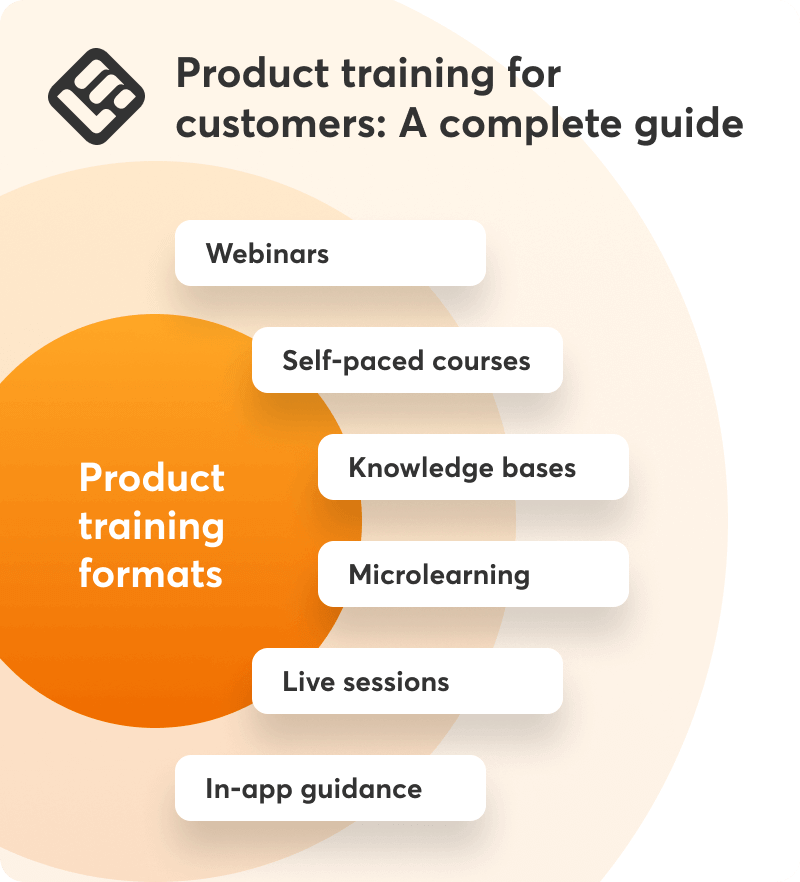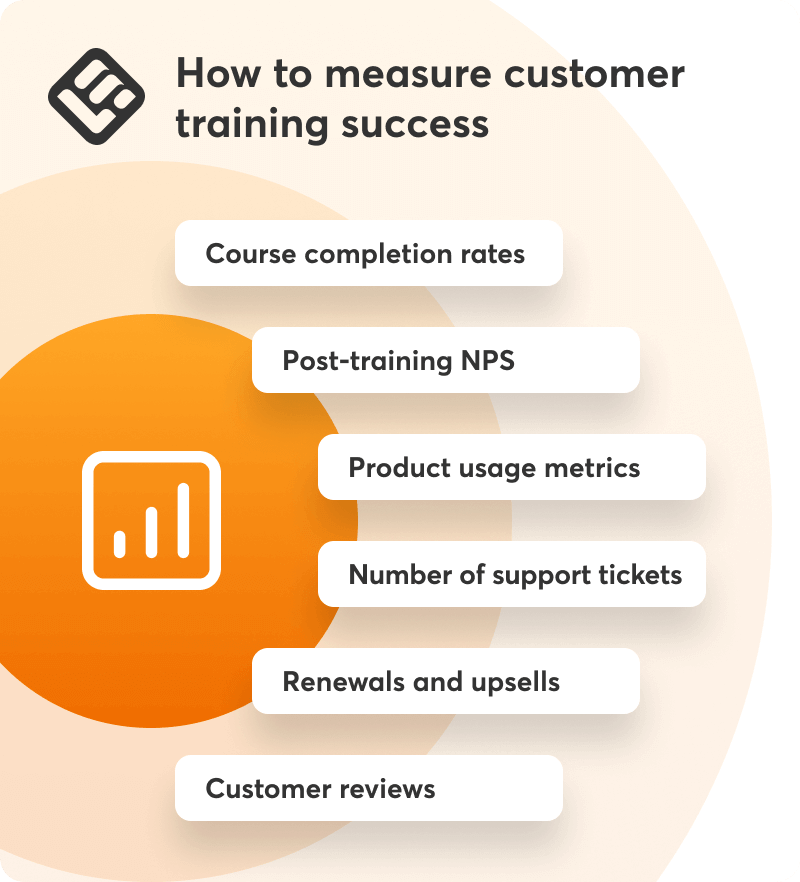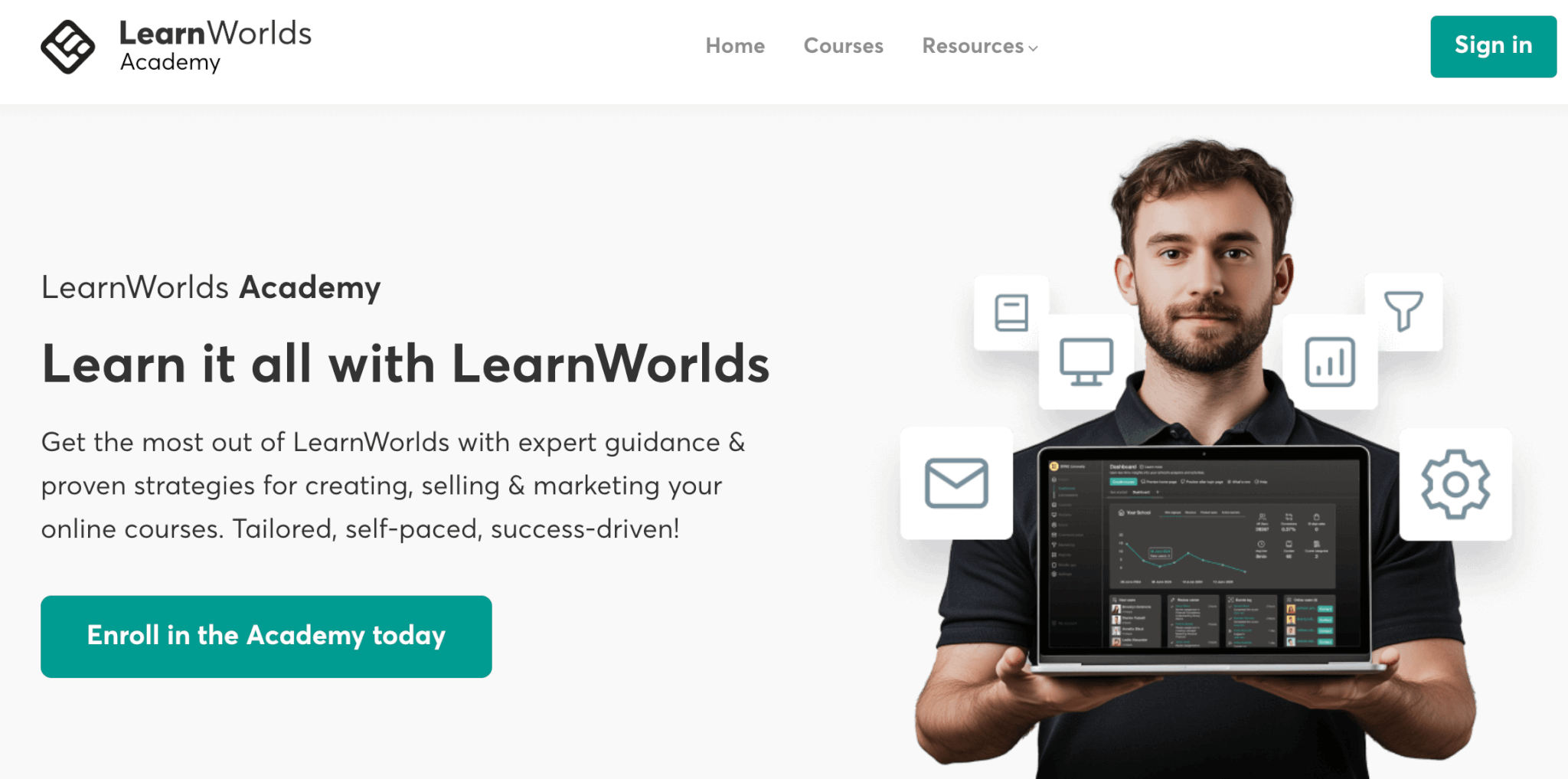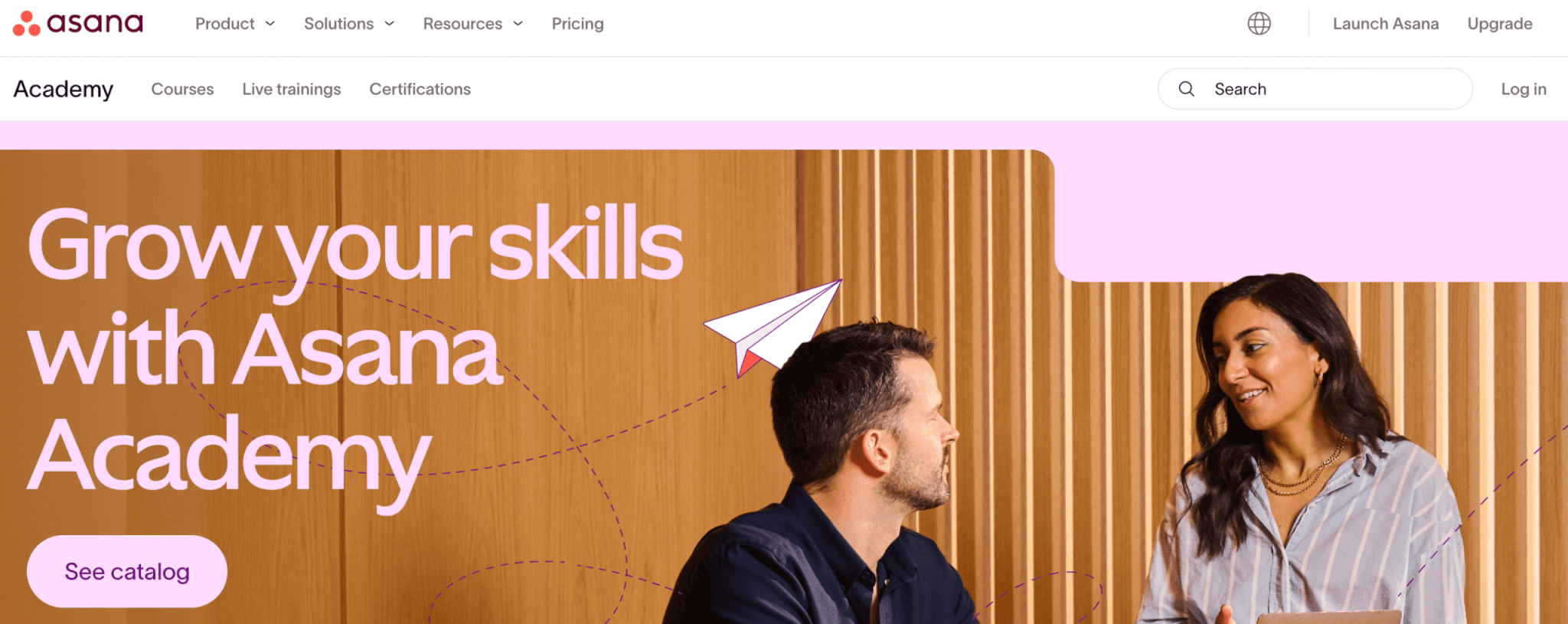Table of Contents
Here’s a shocking truth: delivering a best-in-class or innovative product is only half the battle—the real game-changer is training customers on products, so they can integrate them into their daily routines.
Product training makes all the difference between a frustrated user who gives up on your product and a brand advocate who gets real value out of it.
So, how do you build a successful customer training program? We got you covered.
In this blog post, we explore:
Let’s dive in.
What is customer product training?
Customer product training is a structured educational program designed to help new customers, mostly, and existing ones understand and adopt a product, especially digital ones. Effective customer training programs can dramatically shorten the learning curve, reduce support tickets, and boost customer satisfaction, playing a pivotal role in customer retention and business growth.
For SaaS companies, especially, software onboarding that includes engaging tutorials, walkthroughs, and on-demand learning content is essential to ensure users don’t just activate their accounts, but actually stay and turn into power users.
Is product training the same as onboarding?
Not really. We often hear these terms used interchangeably but they differ significantly, especially in terms of scope, format, and tools used. In fact, the customer onboarding process is only a part of product training.
The following table highlights the key differences between product training and customer onboarding:
7 benefits of customer training
From improving customer satisfaction to establishing your brand in the market, training customers on products offers numerous advantages. Let’s dive into 7 key benefits of customer training and how it transforms the relationship with your customers.
1. Better customer experience
Customer training directly enhances the overall customer experience. When customers know how to use your product confidently and effectively, they get more value from it. This leads to fewer frustrations, more “aha!” moments, and ultimately a more gratifying experience.
2. Higher customer satisfaction
A successful customer training program equips users with the knowledge and skills they need to reach their goals—especially in SaaS customer training, where guidance is critical. When customers feel supported and confident, satisfaction naturally follows.
Well-trained customers are more confident in using your product, which boosts their sense of accomplishment and overall satisfaction. Satisfied customers form stronger relationships with your brand, so you’ll see an improvement in key metrics like CSAT and NPS.
3. Increased product adoption
Comprehensive product onboarding and training lead to higher rates of product adoption, which is one of the ultimate goals. When customers are well-versed in a product’s features and benefits, they are more likely to integrate it into their daily routines and workflows.
4. Enhanced brand loyalty
A customer training program gives you the opportunity to build customer loyalty by creating your own vibrant community where customers connect with each other and your brand. Loyal customers often become brand ambassadors and recommend the product to others, whether among their circle or by leaving positive reviews online.
5. Shorter sales cycle
Customer training is one of the most effective marketing tools as it demonstrates your commitment not only to serve customers but also to see them succeed. Having a strong brand name to work with and a successful customer education academy, your sales reps should be able to close deals faster.
6. Reduced customer support costs
When customers have access to a product training program and a comprehensive knowledge base, they are less likely to ask for assistance. This leads to fewer support tickets and reduced customer support costs, which allows you to allocate resources more efficiently and focus on improving other aspects of your business.
7. Improved customer retention
Investing in customer success through product training courses is a powerful way to retain customers. By prioritizing customer retention, you reduce churn and build a loyal customer base that contributes to long-term business success through repeat purchases and higher customer lifetime value.
How do you train customers? Best formats for your customer training program
When it comes to customer education, one size definitely doesn’t fit all. People learn in different ways, at different paces, and with different goals in mind. Some are tech-savvy, others not so much. That’s why a well-rounded product training program should include a mix of formats—to satisfy different learning styles and help every customer find what works best for them.
Let’s explore some of the most effective (and popular) ways to deliver product training for new customers and now only.

On-demand training resources
On-demand content, like video tutorials, recorded webinars, and help articles, allows your customers to learn at their own pace and at the point of need. Having training materials readily available is a great way to reinforce your training academy and reduce some of the workload for your support and customer success teams.
Self-paced online courses
Sometimes a knowledge base is not enough, and a guided, structured learning experience is in order. That’s where self-paced learning comes in, in the form of online courses, to give users a clear path through the product, broken down into manageable lessons they can complete whenever it suits them. Self-paced courses are very often tied to certificates, which adds extra value to the experience and offers you the chance to monetize your academy.
Live training and webinars
Hosting live training sessions or webinars lets you engage customers better than anything else and connect directly with them, answer their questions in real-time, and walk them through key features or use cases.
It’s especially helpful when rolling out new updates or onboarding high-paying clients who might need more support. And the best part? You can record these sessions and use them later as on-demand content.
Microlearning
Not everyone has time to sit through a full course or webinar, and that’s where microlearning for customers shines—think two-minute videos or quick “how-to” tips that help customers solve specific problems fast. Two key benefits of microlearning are that it doesn’t overwhelm users, and it fits perfectly into the fast-paced way most people use digital tools today.
In-app tutorials
In-app tutorials are interactive guides that pop up right inside the software and walk users through features step-by-step. In-app learning is incredibly effective for onboarding and helping new customers get value from your product right away, without ever leaving the platform.
💡 Product adoption platforms offer in-app tutorials, checklists, and other useful tools to guide new users through their first steps. Check out the best product adoption software platforms in our respective blog post.
How to build an effective product training program for customers
To create a successful product knowledge training program, you need to develop a strategy that accounts for the unique needs of your customers. Whether you’re launching a brand-new initiative or refining an existing one, a customer learning journey that is built based on actual needs and business goals will help ensure lasting impact.
Although no two customer training programs are alike, some best practices and strategies can make yours not only effective but also scalable and truly engaging.
Here’s how to do product training right:
1. Start with a strategy
Before building anything, step back and define the big picture. What are you trying to achieve with your training program? Think beyond content and ask: how will this program drive product enablement, reduce churn, or improve onboarding?
This strategic foundation will help you align your training with both customer needs and company objectives. It also gives you a clear direction when choosing tools (like a training platform) or delivery formats later on.
2. Know your audience
Not all customers need the same kind of training. A first-time user requires different support than a seasoned power user. Similarly, enterprise teams may expect in-depth training and live demos, while individual users might prefer self-serve onboarding.
Understanding your different customer segments—for example, by role, industry, use case, or level of experience—will help you design a program that is relevant and valuable to each group. This level of personalization plays a big part in boosting engagement and learning outcomes.
3. Define learning objectives
Your goals might include increasing customer satisfaction, reducing support tickets, improving feature adoption, or even driving upsell opportunities. The key is to align your training objectives with broader business outcomes, so that every piece of content plays a role in moving the needle.
Clear training objectives are your roadmap. What should customers be able to do or understand after completing your training? What will be the impact of training on your business? Skipping this step is one of the most common customer education mistakes—and one that can waste time, budget, and customer trust.
4. Collaborate with Subject Matter Experts
The best product training content is accurate, detailed, and easy to understand. That’s why you need to work closely with subject matter experts (SMEs), like product managers or engineers. SMEs help ensure your content reflects real use cases and captures key product nuances. Their insights can turn “feature lists” into meaningful lessons that help customers succeed.
5. Leverage tech tools
Using the right technology can elevate your program from basic to brilliant. A powerful training platform, like a Learning Management System (LMS), lets you create, organize, and deliver scalable training programs.
Tools like digital adoption platforms offer in-app tutorials, behavioral metrics, and even gamification features like points or badges. All of these increase customer engagement while making learning more effective and enjoyable.
💡 If you’re still wondering, “What platform should I use for training customers?” check out the best customer training tools for the job in our blog post.
6. Personalize training content
Customers want training that speaks to them. Tailor your content based on who’s watching: industry-specific examples, job-role relevance, and different paths for beginners vs. advanced users can go a long way.
Deliver training through a blend of self-paced learning, real-time webinars, and microlearning formats. Give customers access to an always-on library of resources they can explore when it’s convenient for them—this flexibility is especially important in digital product environments.
7. Facilitate peer learning
Creating space for customers to learn from one another adds a social aspect to your customer training programs. Whether it’s through a dedicated community, discussion forum, or social media group, peer learning builds trust and loyalty.
It’s also a great way to highlight success stories, troubleshoot common issues, and make customers feel like they’re part of something bigger than just a product, and develop a deeper connection to your brand.
8. Promote the program
Use in-app messages, website banners, onboarding emails, and social media to let customers know that your product training program is waiting for them. And don’t forget to equip your sales, customer support, and customer success team with messaging so they can personally guide customers to the training.
9. Collect customer feedback
Ask for customer feedback regularly, after courses, during check-ins, or via surveys, to learn what’s working and what’s not. Use this feedback to refine training materials, offer new delivery formats, or even identify new topics to cover. The more you listen, the more responsive and effective your program will become.
10. Keep reiterating and improving
Your product is always evolving, and your training should be too. Keep an eye on product updates, feature launches, and changes in customer behavior to keep your materials fresh.
Use analytics to spot gaps and track performance over time. Are customers dropping off at a certain module? Are certain formats outperforming others? Use those insights to make data-driven updates that keep your training effective, engaging, and aligned with the full customer learning journey.
How do you measure ROI from customer training? Metrics that tell the tale
Creating a customer training program is just the beginning—its real power lies in how well it performs over time. To make sure your efforts are driving results, it’s essential to track, measure, and continuously improve. By using a combination of quantitative data and customer insights, you can fine-tune your training strategy to better serve your users and business goals.
Let’s explore some of the most reliable and insightful ways to evaluate your program’s performance through key training KPIs and customer learning analytics.

Course completion rates
A straightforward but important course engagement metric, completion rates show whether customers are making it through your training materials. Low completion rates may suggest that your courses are too long, not relevant, or lacking in engagement. High completion rates, on the other hand, are a sign that your training is hitting the mark.
Dive even deeper to learn: Are users dropping off at a specific module? Are they rewatching certain sections? How do they score at quizzes? How many certificates have been issued? These secondary metrics can reveal where learners lose interest or where content could use clarification.
Net Promoter Score (NPS)
NPS is a trustworthy indicator of customer satisfaction and loyalty. Asking “How likely are you to recommend this product after completing the training?” gives you direct insight into how education impacts the customer experience.
Tracking NPS trends over time, plus comparing NPS scores for trained vs. untrained users, helps you evaluate the long-term value of your program and how well it supports overall customer advocacy.
Product usage metrics
One of the clearest indicators of effective training is increased product usage. Look at behaviors such as:
By linking these behaviors back to training milestones, you can better understand how learning influences action. These customer learning analytics give you evidence that your content isn’t just being consumed but change how customers use your product.
Support ticket analysis
Support ticket volume is linked to customer self-sufficiency. If your training program is effective, support requests for basic tasks or common issues should decrease.
Drill down into ticket categories to spot recurring issues that may need more coverage in your training content. Use before-and-after comparisons to identify where training has helped reduce dependency on your support team and where further education might still be needed.
Revenue and sales
Training builds more than knowledge, it fosters business growth. Track the impact of your training efforts on revenue-based KPIs like:
When customers are well-trained, they’re more likely to stick around and expand their usage. Aligning training data with these sales metrics helps prove the ROI of customer education and reinforces training as a revenue driver.
💡 Read more about how to see a positive ROI from customer education from customer education expert Vicky Kennedy.
Customer reviews
Customer reviews offer a qualitative, real-world look at how your training translates into positive outcomes. If customers are calling out your training resources in public reviews—or leaving glowing testimonials about how your courses helped them succeed—that’s validation money can’t buy.
Monitoring platforms like G2, Capterra, or even internal case studies can provide valuable social proof and surface meaningful praise (or critiques) that you can use to improve your program.
Real examples of great product training
LearnWorlds Academy

At LearnWorlds, we don’t just help others create powerful learning experiences—we do it ourselves. The LearnWorlds Academy is a flagship example of how to build and deliver exceptional product training that empowers customers at every stage of their journey.
Why it works:
LearnWorlds Academy is a prime example of using your own product as a training platform—turning education into a key part of product enablement, customer success, and brand loyalty.
Watch our recent webinar to find out how we did it:
Asana Academy

Asana, the popular project management platform, has built Asana Academy as a comprehensive learning hub to help users make the most of its features. Designed to guide customers from basic task management to advanced workflows, the Academy plays a key role in driving product adoption and long-term success.
Why it works:
Asana Academy is a prime example of how SaaS companies can use customer product training to power both onboarding and ongoing value. It’s a model of what great self-paced learning and virtual product training should look like—clear, relevant, and designed around the customer journey.
Final thoughts
Customer product training is a powerful tool that boosts user satisfaction and loyalty.
By offering personalized training and not merely a one-size-fits-all knowledge base with user manuals, you equip customers with the skills to gain the most value out of your product. This, in turn, leads to multiple benefits for your business.
As you embark on this exciting initiative, you’ll need a reliable customer education platform like LearnWorlds. With powerful features, like AI assistant, interactive content, built-in community, multiple schools, user roles and user groups, customer service and CRM integrations, and many, many more, you know you can lean on LearnWorlds for an utterly engaging, scalable, and effective customer training.
Don’t wait another day. Try LearnWorlds with a 30-day free trial now.

Androniki Koumadoraki
Androniki is a Content Writer at LearnWorlds sharing Instructional Design and marketing tips. With solid experience in B2B writing and technical translation, she is passionate about learning and spreading knowledge. She is also an aspiring yogi, a book nerd, and a talented transponster.




